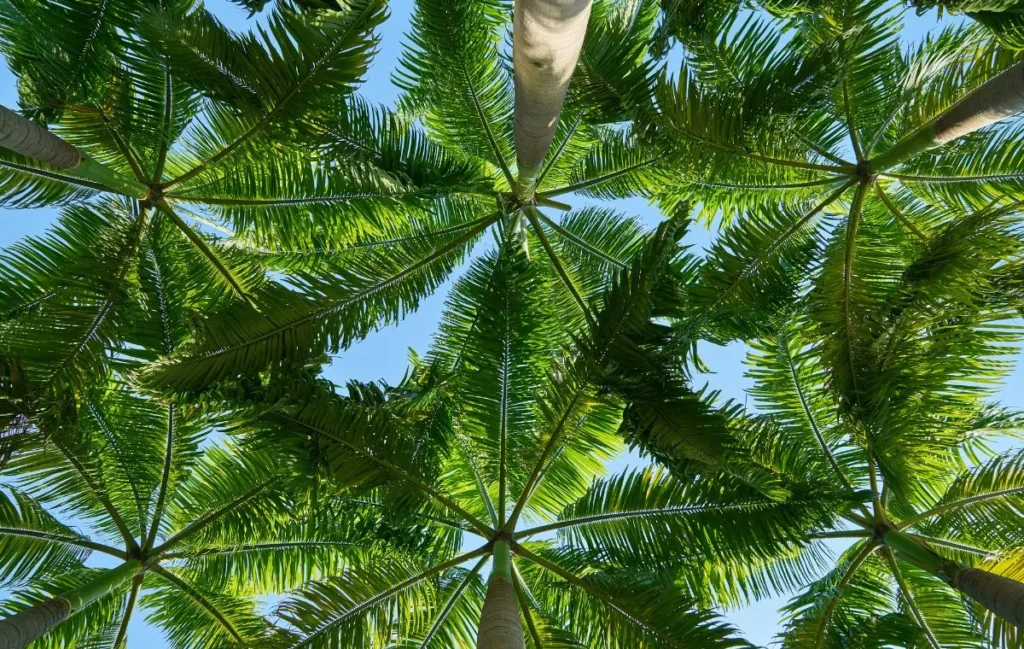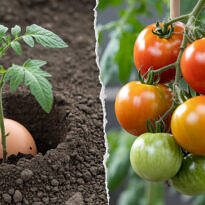Have you ever considered the incredible diversity of palm trees and the visual impact they can add to any landscaping project?
Why are they so often associated with tropical paradises and luxurious gardens around the world? Palms, members of the Arecaceae family, are not only an iconic symbol of tropical climates but also an extremely versatile plant, adapting well to various environments and uses.
But what exactly makes a plant a palm tree?
And why are some plants like the Ravenala, commonly known as the “Traveler’s Tree,” and the Cycas, often mistaken for palm trees? In this article, we’ll explore these questions while diving into the fascinating world of palm trees, clarifying in detail their defining characteristics and the wide variety of types available.
Palm trees are easily recognizable by their long, slender trunks, the stipes, and by the broad fronds that often unfold majestically like plumes at the top of these trunks. These characteristics can vary dramatically among the approximately 2,600 species within the Arecaceae family. Some palms have thick, robust trunks, while others are elegant and slender; some grow to vertiginous heights, and others remain close to the ground. Additionally, while most display a single trunk, other species are clumped, creating a quite distinct group effect.
Why, then, are plants like the Ravenala and Cycas often confused with palm trees?
The answer lies mainly in their superficial appearance. The Ravenala, although not a true palm tree, has large leaves that resemble the fronds of palm trees, and Cycas, although belonging to a completely different group of plants, have a growth form that may remind one of palms. However, biologically speaking, these plants are quite distinct from true palm trees. They belong to other plant families.

But with so many types of palm trees available, how do you choose the ideal one for your garden, home, or landscaping project?
Through this detailed guide, let’s learn about the different classifications of palm trees, from those ideal for temperate climates to those perfect for decorating indoor environments. We’ll explore the diversity and utility of these extraordinary plants to help you make the best choices for your spaces. Get ready to unveil the world of palm trees and discover how these magnificent plants can transform any setting!
1. Classification by Growth Type
Palm trees can be broadly classified based on the growth type of their trunks, also known as stipes. This classification helps determine the landscaping use and the space required for growing palm trees, being essential for planning gardens, public spaces, and interiors.
A. Single Stipe Palms
Single stipe palms have a single trunk that grows vertically, making them imposing and elegant. They are often used as central pieces in landscaping projects due to their striking vertical structure, which can add drama and a visual focal point to the setting. They are also great for forming rows along walls, flanking avenues, or in central flowerbeds. Examples:

- Cuban Royal Palm (Roystonea regia): Notable for its smooth, grey trunk and a lush crown of leaves. It is perfect for boulevards and large avenues with a significant visual impact.
- Veitchia Palm (Veitchia arecina): A noble and ornamental palm, native to the New Hebrides Islands, which can reach up to 65 feet (20 meters). It tolerates tropical, subtropical, and warm temperate climates.
- Date Palm (Phoenix dactylifera): This palm is valued both for its ornamental appearance and its edible fruits, common in desert landscapes.
- Petticoat Palm (Washingtonia filifera): With a tall, sturdy trunk, often used in rows to create striking visual effects.
- Areca Palm (Areca catechu): Popular in the tropics, used in decoration and also in the production of areca nuts.
- Silver Fan Palm (Coccothrinax argentata): Typical of coastal regions, this Caribbean-origin palm reaches up to 33 feet (10 meters) tall, is elegant, and has decorative fruits.

B. Clumping Palms
Clumping palms grow in groups of trunks, typically originating from a common base, a rhizome that interconnects them. This type of growth creates a dense texture and is ideal for privacy, in hedge fences, or as natural barriers in landscaping. The cluster of several trunks gives the palm a full appearance and allows it to regrow if any of the stems are lost due to breakage or pest attack, for example.

- Bamboo Palm (Chamaedorea seifrizii): An ideal choice for interiors and areas with partial shade in outdoor gardens due to its compact size.
- Areca Palm (Dypsis lutescens): Widely used in offices and homes, it is known for its air purifying capabilities.
- Sealing Wax Palm (Cyrtostachys renda): A stunning tropical species that adds a touch of color and visual drama to any landscape, perfect for creating focal points in tropical gardens and leisure areas.
- Fishtail Palm (Caryota mitis): Its leaves, resembling fish tails, provide intriguing visual texture to any space.
- Açaí Palm (Euterpe oleracea): Native to Brazil, this palm is widely used for its delicious and nutritious berries, and high-quality heart of palm. Unlike the Jussara palm’s heart of palm, harvesting the Açaí does not kill the plant since it clumps.
- European Fan Palm (Chamaerops humilis): The only native palm of Europe. It is quite large and clumpy, requiring spacious gardens.

2. Classification by Climate
Palms have a remarkable ability to adapt to different climate conditions, which allows their cultivation in a wide variety of environments around the world. They can be classified based on their ability to tolerate tropical or temperate climates, offering diverse options for landscaping and home gardening.
A. Palms for Tropical Regions
Palms that thrive in tropical climates generally prefer high temperatures and a good amount of humidity. They are ideal for creating an exotic, paradisiacal environment in gardens and leisure areas.

- Coconut Palm (Cocos nucifera): Widely grown in coastal regions, it is renowned for its fruits, the coconut, and its resistance to wind and salinity.
- Normanbya Palm (Normanbya normanbyi): Native to Australia, this imposing palm is still rarely used in landscaping.
- Giant Fan Palm (Licuala grandis): With its round, peltate leaves, this species is a favorite for decorative tropical gardens.
- Christmas Palm (Adonidia merrillii): Ideal for urban landscaping due to its medium size and decorative red fruits that typically appear in winter.
- Palmyra Palm (Borassus flabellifer): A robust palm that is both a food source and a traditional element in Asian landscapes.
- Bacaba (Oenocarpus distichus): With a curious crown resembling the traveler’s palm, this palm from central-northern Brazil reaches heights of 33 feet (10 meters) and is solitary.

B. Palms for Temperate Regions
Palms for temperate regions are resilient selections that can withstand colder temperatures and weather challenges like frost and even snow, perfect for adding a tropical touch to colder climates. They are ideal for the subtropical and temperate climate, as long as it is not too cold.

- Windmill Palm (Trachycarpus fortunei): One of the most cold-resistant palms, popular in many European and North American gardens.
- Needle Palm (Rhapidophyllum hystrix): Extremely cold-tolerant, this small palm can survive temperatures below zero.
- Dwarf Blue Palm (Sabal minor): Another hardy species, which prefers drier and colder climates, perfect for sustainable landscaping.
- Chilean Wine Palm (Jubaea chilensis): This palm can withstand both cold and drought, making it ideal for variable climates.
- Pindo Palm (Butia capitata): With its blue-green leaves and edible fruits, it is an excellent choice for gardens in temperate climate areas.
- Guihaia (Guihaia argyrata): A small, multistemmed palm native to mountainous regions of China and Vietnam.

3. Classification by Planting Location
Palms are extremely versatile and can be used in a wide variety of environments, both indoors and outdoors. The appropriate choice of species is essential to ensure that the plant not only survives but also thrives and fulfills its aesthetic and practical role in landscaping.
A. Palms for Indoors
Palms that adapt well to indoor environments usually require less direct sunlight and are more tolerant of temperature and humidity variations, typical of enclosed spaces. Generally, most palms, especially those originating from tropical forests, adapt well in their juvenile stages in indoor environments, where lighting is less.
But as soon as they reach the ceiling (or a little before), they should be moved to the garden, and gradually exposed to direct sunlight. Imagine that in their natural habitat, while the young palm does not reach the forest canopy, it is shaded by taller trees. But as soon as it passes the canopy of the trees, it begins to be bathed in direct sunlight.

- Kentia Palm (Howea forsteriana): A favorite for offices and living rooms, it has slow growth and elegant leaves that adapt well to environments with low light.
- Dwarf Date Palm (Phoenix roebelenii): With its compact size and fine, arched leaves, this palm is ideal for small spaces and tolerates the dry air of heated indoor environments well.
- Parlor Palm (Chamaedorea elegans): It has a slender trunk and delicate leaves, perfect for decorating hallways and room corners.
- Lady Palm (Rhapis excelsa): Another excellent choice for interiors, known for its durability and low need for direct sunlight, although it requires plenty of humidity.
- Metallic Palm (Chamaedorea metallica): A clumping palm with a distinctive visual appeal with its metallic leaves, and adapts very well to indirect light conditions, ideal for interiors.
- Camedorea Palm (Chamaedorea ernesti-augusti): Native to Mexico, this solitary and elegant little palm, with black fruits, is ideal for indoor environments.

B. Palms for Gardens
Palms for outdoor gardens need to be more resistant to climatic variations and capable of thriving under greater exposure to sun and wind from the beginning of their lives. This allows even young seedlings to be planted in the garden without suffering from burns. Some species, however, as mentioned in the previous topic, can adapt to the outdoor garden, provided they are no longer young. This is the case with Bamboo Areca (Dypsis lutescens), for example.

- Washingtonia (Washingtonia robusta): Fast-growing and impressive in stature, it is a majestic focal point for large gardens.
- Palmetto (Sabal palmetto): A hardy and moderately growing palm, great for coastal gardens or spaces where large trees are not feasible.
- Bottle Palm (Hyophorbe lagenicaulis): Its uniquely inflated trunk can be an interesting focal point in gardens.
- Chinese Fan Palm (Livistona chinensis): With fan-shaped leaves, it provides pleasant shade, ideal for outdoor living areas.
- Jelly Palm (Syagrus romanzoffiana): Its ability to adapt to different soil types makes it a popular choice for landscapers and gardeners looking for a practical and beautiful option for both large and small gardens.
- Golden Areca (Areca vestiaria): With an orange trunk, this beautiful palm appreciates semi-shaded areas and can reach heights of 10 to 20 feet (3 to 6 meters).

C. Palms for Poolside Areas
Choosing the right palms to plant near swimming pools is crucial to avoid maintenance and safety issues. Ideal species for this area should have roots that do not interfere with underground structures and are less prone to shedding leaflets or fronds, minimizing the need for cleaning around the pool.
Despite these species of palms being suitable for planting near pools, it is crucial to respect a minimum distance from piping and built-up areas. This ensures that the roots have adequate space to grow without the risk of damaging the pool structure or underground facilities. As a general rule, it is recommended to keep palms at least 6 feet (2 meters) away from the edges of the pool and built-up areas, adjusting according to the expected root size of the chosen species. Remember that the roots of the palm are approximately the size of the crown’s projection.

- Field Palm (Syagrus flexuosa): This palm features clumped growth that helps control its roots, making it ideal for locations near pools.
- Kentia Palm (Howea forsteriana): Known for its sturdy leaves that rarely fall, the Kentia is a popular choice for decorating poolside areas, offering a tropical look without the mess.
- Mexican Fan Palm (Washingtonia robusta): Although it can reach impressive heights, its roots are relatively non-invasive, and it is tolerant of a variety of weather conditions, ideal for outdoor pools.
- Bamboo Palm (Chamaedorea seifrizii): Its compact roots and clumping growth habit make this palm a great option for limited areas, such as those around pools. Additionally, they are smaller and more delicate.
- Saw Palmetto (Serenoa repens): A low-growing palm, usually reaching about 6 to 10 feet (2 to 3 meters) in height, making it ideal for limited spaces around pools.
- Sugar Cane Palm (Dypsis baronii): Its stem features scars that make it resemble the stems of sugar cane. This palm is native to Madagascar.

4. Classification by Use
A. Fruit-Producing Palms
Palms are not only beautiful additions to landscaping; many species are also grown for their nutritious fruits, which are valuable ingredients in local and international cuisine. Besides their food value, some of these palms are used in the production of biofuels and other industrial products, making them vital for regional agricultural economies.
Palm fruits like dates, coconuts, and açaí are commercially important and globally recognized. These palms can be an excellent choice for gardens in appropriate regions where the climate favors their fruitful development. Besides providing shade and beauty, these trees can offer a substantial economic return when planted in large numbers.

- Macaúba Palm (Acrocomia aculeata): Native to Brazil, it produces fruits rich in oils that are used both for food and for producing biofuels.
- Peach Palm (Bactris gasipaes): Mainly cultivated for its palm hearts and edible fruits, it’s a popular choice in tropical landscaping.
- Guariroba Palm (Syagrus oleracea): Its large leaves and fruits are used in regional Brazilian cuisine.
- Senegal Date Palm (Phoenix reclinata): Produces dates in more humid climates and is often used in reforestation projects for degraded areas.
- Thorny Caribaea (Aiphanes aculeata): Thorny, this palm produces fruits rich in carotenoids, which give them a beautiful red color. They are widely marketed in Colombia.
- Snake Fruit (Salacca zalacca): With scaly, sweet, and tart fruits, this fruit-bearing palm is native to Java and Sumatra in Indonesia.

B. Ornamental Palms
Ornamental palms are chosen mainly for their unique aesthetic characteristics, such as shape, foliage color, and overall stature that can complement any landscape design. These species are often used in gardening projects to add sophistication and an impressive focal point.
Due to their variety, ornamental palms can be found in many environments, from small residential gardens to large public and urban spaces. With their striking structures, these palms are capable of creating a tropical or exotic atmosphere, even in areas where the climate is not typically suitable for most tropical species.
Each of these ornamental palms brings a distinct visual identity to landscaping, allowing designers to explore different themes and styles. Whether seeking a modern minimalist look with clean lines and geometric shapes, or a more traditional and robust arrangement, there is always an ornamental palm that can be the perfect choice.

- Foxtail Palm (Wodyetia bifurcata): With leaves resembling a fox’s tail, it is ideal for modern gardens.
- Blue Palm (Bismarckia nobilis): Valued for its distinct silvery-blue leaves, it provides a striking contrast in green landscapes.
- Triangle Palm (Dypsis decaryi): Its unique triangular shape attracts garden designers looking for natural geometric forms.
- Spindle Palm (Hyophorbe verschaffeltii): With a robust, spindle-shaped stem, it is a highly ornamental and attractive option.
- Solitary Palm (Ptychosperma elegans): With an elegant stature and delicate leaves that are excellent for ornamentation.
- Splendid Palm (Verschaffeltia splendida): With aerial roots that elevate the plant, this palm gives the impression it could walk away.

C. Palms for Heart of Palm Production
Heart of palm, a delicate and tasty food extracted from the interior of certain palms, is a delicacy enjoyed in many cultures around the world. Palms that produce heart of palm are especially valued in regions where it constitutes an important part of the local diet, such as in Brazil. Besides their gastronomic value, the cultivation of palms for heart of palm production also plays a significant role in the agricultural economy of various regions.
Unlike other crops, heart of palm is harvested by felling the tree, which can lead to unsustainable practices if not managed correctly. Some species, like the Açaí (Euterpe oleracea), are more sustainable because they allow multiple harvests throughout the life of the palm, as they are not killed for heart of palm extraction, sprouting again afterwards.

- Juçara (Euterpe edulis): Its heart of palm is highly valued in Brazilian cuisine; however, harvesting threatens the species’ survival in the wild.
- Prestoea acuminata: With tasty heart of palm, this palm native to Tropical America is threatened with extinction due to rampant harvesting. Its use in reforestation and landscaping projects are interesting for maintaining the species.
- Amazonian Açaí (Euterpe precatoria): Dual-function, a single-stemmed palm that produces both açaí and delicious heart of palm.
- Peach Palm (Bactris gasipaes): In addition to the fruits, heart of palm is one of the main reasons for its cultivation.
- Imperial Palm (Roystonea oleracea): The heart of palm from this palm is used in various culinary preparations around the world.
- King Palm (Archontophoenix cunninghamiana): Appreciated for its tall trunk and feathery leaves, ideal for tropical and subtropical gardens and is a promising producer of heart of palm.

D. Other Useful Palms
Beyond their applications in landscaping and cuisine, many palms have industrial and commercial uses that make them valuable for various other applications. These uses include the production of fibers, oils, and even building materials.
- Fibers: Some palms, such as the Raffia Palm (Raphia farinifera) and the Tucum Palm (Astrocaryum vulgare), are cultivated for the quality of their natural fibers, which are used in the manufacture of ropes, baskets, rugs, and other artisanal items. These fibers are appreciated for their durability and sustainability, offering an eco-friendly alternative to synthetic materials.
- Oils: Many palms are important sources of oils used in foods, cosmetics, and industry. Coconut oil, extracted from the Coconut Palm (Cocos nucifera), is perhaps the most well-known, but many other palms, including the Carnauba Palm (Copernicia prunifera) and the Buriti Palm (Mauritia flexuosa), produce oils that are valued for their unique properties.
- Building Materials: Palms also provide building materials, such as wood and leaves for roofing. In many tropical regions, the leaves of palms like the Petticoat Palm (Washingtonia filifera) are used to cover homes, providing natural insulation against heat and rain.
These utilities make palms extremely versatile and sustainable resources, contributing not only to the local economy but also to eco-friendly and sustainable living practices.
Examples of useful palms:

- Carnauba Wax Palm (Copernicia prunifera): Produces a wax used in various products, from cosmetics to car polish.
- Raffia Palm (Raphia farinifera): Its fibers are used in the manufacture of ropes, baskets, and even mattress stuffing.
- Babassu (Attalea speciosa): Valuable both for its fruits, which are used in the production of oil and flour, and for its leaves, employed in the manufacture of crafts and roof coverings.
- Tucum Palm (Astrocaryum vulgare): Its fibers are employed in the production of crafts and in the making of bags and nets.
- Buriti Palm (Mauritia flexuosa): The oil extracted from its fruits is used in cosmetics; the leaves are used to cover houses and make crafts.
- African Oil Palm (Elaeis guineensis): The oil from this African palm, known as palm oil, has been consumed for over five thousand years in cuisine.

5. Classification by Height
Palms can vary greatly in height, from low-growing species that are ideal for smaller gardens or as understorey plants, to giants that dominate the landscapes where they grow. This classification is crucial for landscape planning, especially in urban areas where space may be limited.
A. Low-Growing Palms
Low-growing palms are perfect for smaller spaces, areas under taller trees, or to create layers of vegetation in a landscape design. They rarely exceed 30 feet (10 meters) in height and many stay well below that.

- Licuri Palm (Syagrus coronata): A small palm native to Brazil, ideal for compact gardens and landscaping.
- Aricuriroba (Syagrus schizophylla): Native to Northeast Brazil, where it grows in restinga areas, this little palm rarely exceeds 13 feet (4 meters).
- Dwarf Palmetto (Sabal minor): Small and robust, this palm is often used in groups to create a dense, green effect.
- Blue Needle Palm (Trithrinax campestris): Hardy and low-growing, it offers a unique texture with its rigid and spiny leaves.
- Florida Palmetto (Sabal etonia): Native to Florida, this palm up to 7 feet (2 meters) is ideal for smaller gardens in subtropical landscapes.
- Fishtail Palmlet (Arenga caudata): Ideal for indoor cultivation, this little palm native to Vietnam reaches up to 4 feet (1.2 meters) in height.

B. High-Growing Palms
High-growing palms are majestic and can serve as impressive focal points in large landscapes. They need substantial space to grow, both above and below the ground, due to their large roots.

- Carpentaria Palm (Carpentaria acuminata): Tall and slender, this Australian species is perfect for avenues and parks.
- Fishtail Palm (Caryota urens): One of the few palms with bipinnate leaves, it grows tall and is ideal for creating a dramatic tropical backdrop.
- Fiji Palm (Pritchardia pacifica): With its large stature and wide leaves, it is a visual interest point in any landscape.
- Talipot Palm (Corypha umbraculifera): One of the largest palms in the world, it is known for its gigantic size and leaf longevity.
- Royal Palm (Archontophoenix alexandrae): Famous for its rapid growth and impressive height, it is a common sight in tropical landscapes.
- Wax Palm (Ceroxylon quindiuense): Considered the tallest among palms, native to the Andes, it can reach incredible heights of up to 200 feet (60 meters).

6. Classification by Drought Tolerance
Palms are often associated with humid tropical landscapes, but many species have adapted to survive in environments with low water availability. This ability to resist drought makes certain palms extremely valuable for landscaping in arid regions or for gardeners wishing to reduce water consumption. Below, we explore palms that show different levels of drought tolerance.
A. Drought-Resistant Palms
These palms can survive with little water and are ideal for dry climates or for sustainable landscaping that seeks to minimize irrigation.

- Canary Island Date Palm (Phoenix canariensis): Originating from the Canary Islands, this palm is notable for its robustness and ability to tolerate long periods without water once established.
- Mexican Blue Palm (Brahea armata): With its impressive silvery-blue leaves, this palm not only tolerates drought but also adds a dramatic touch of color to any landscape.
- California Fan Palm (Washingtonia filifera): One of the most iconic desert palms, known for its thick trunk and high drought tolerance.
- Palmetto Palm (Sabal palmetto): Widely grown in the southeastern US, this palm is valued for its resilience to various environments, including periods of drought.
- Jelly Palm (Butia capitata): Native to Brazil, this palm is popular in temperate climate areas and is known for its ability to withstand periods without rain.
- Guadalupe Palm (Brahea edulis): This palm native to Mexico, can survive in environments with annual rainfall below 6 inches (150 mm).

B. Palms that Require Lots of Water
Contrasting with drought-resistant species, these palms need moist conditions and frequent watering to thrive, making them ideal for more humid regions or for gardens with good irrigation systems.

- Coconut Palm (Cocos nucifera): Perhaps the most classic image of a palm, the Coconut thrives in conditions of high humidity, especially in tropical coastal regions.
- Vanuatu Palm (Pelagodoxa henryana): A rarity in the world of palms, this species prefers extremely humid environments and does not tolerate drought.
- Cabbage Palm (Livistona australis): With its large fan-shaped leaves, this palm is ideal for regions with high humidity and well-irrigated soils.
- Royal Palm of Cuba (Roystonea regia): Originating from Cuba, this majestic palm is often found in environments that offer an abundance of water.
- Christmas Palm (Adonidia merrillii): Popular in the tropics, this palm requires moist conditions for optimal development and is often seen in irrigated landscapes.
- Bahia Piassava Palm (Attalea funifera): Known for its useful fibers, the Bahia Piassava appreciates water for good growth and productivity.

Other Aspects to Consider When Choosing Your Palm
When choosing a palm for your garden or landscaping project, it is important to consider several factors beyond climate and growth type. The right choice can ensure not only the survival of the palm, but also its prosperity and harmonious integration into the environment.
Native or Exotic
The decision between a native and an exotic palm can impact not only the local ecosystem but also the ease of maintenance and resistance to pests and diseases. Native palms tend to be more adapted to local conditions and can contribute to local biodiversity, while exotics, when carefully chosen, can add a unique element to the landscape.
Growth Speed
Considering the growth speed is crucial for planning space and managing time. Fast-growing species, such as Archontophoenix alexandrae, can provide cover or privacy quickly, but may also require more frequent pruning. On the other hand, slow-growing palms, like Sabal palmetto, although they take longer to establish, generally require less maintenance.
Proportion in Relation to the Building
The scale of the palm in relation to the surrounding environment, especially buildings, is key to the aesthetics of the landscaping. A very tall palm next to low buildings can look disproportionate, while lower species may be perfect for indoor gardens or as understorey plants.
FAQ: Caring for Palms
1. How should I plant a palm?
Proper planting is essential for success in growing palms:
- Ideal Time: The best time to plant is at the beginning of the rainy season.
- Soil Preparation: Dig a hole that is at least twice as large as the palm’s root ball to facilitate root growth. Enrich the removed soil with organic compounds to promote a rich environment for the plant’s development.
- Installation: Position the palm carefully in the hole, ensuring it is vertical and centered, and fill the space with the enriched soil.
2. What is the correct way to transport a palm?

- Protection: During transportation, protect the roots and leaves to avoid damage. If possible, use supports or covers that minimize physical contact with these sensitive parts. Avoid abrupt movements that might break or damage roots or the palm heart.
- Positioning: Always keep the palm in a vertical position and ensure it is well secured to prevent tipping. Bracing may be necessary in the initial phases after transplanting.
3. How to transplant a palm?
- Root Preservation: Try to keep the root system as intact as possible and keep it moist during the transplant.
- Post-Transplant Care: Palms withstand transplanting well if proper care is taken. After positioning the palm in its new location, water it abundantly to help in recovery and adaptation to the new environment.
4. What are the necessary maintenance care for palms?
- Irrigation: Palms need to be watered regularly, especially during periods of drought. The frequency and amount of water will depend on the climate and soil.
- Fertilization: Use fertilizers suitable for palms during the growth phase to adequately nourish the plant.
- Pest and Disease Control: Inspect the plant frequently for signs of problems and treat them promptly using the methods and products recommended for each case.
5. How and when to prune a palm?
- When to Prune: Pruning should be performed when there are visibly dead, damaged, or diseased leaves. It is not recommended to prune excessively (no more than the lower half of the crown), as this can stress the plant and cause indelible marks on the trunk (narrow parts).
- Pruning Method: Use clean and sharp pruning tools to make precise cuts. Avoid cutting the trunk or removing healthy leaves, as this can harm the health and growth of the palm.
- Palm Heart: It is impossible to prune a palm at height. We can only remove excess stems (from clumping palms), or remove old leaves before they fall. If any cuts are made, on young leaves or the palm heart, the chances are that the palm will die, especially if it has a single stem.

Ready to Choose Your Palm Type?
With so many options available, there is certainly a palm that is perfect for your garden or landscaping project. Consider the local conditions, the desired characteristics, and use the tips from this guide to help in your decision. We want to know: which palm will you choose? Share your plans with us and seek further advice if necessary!







